

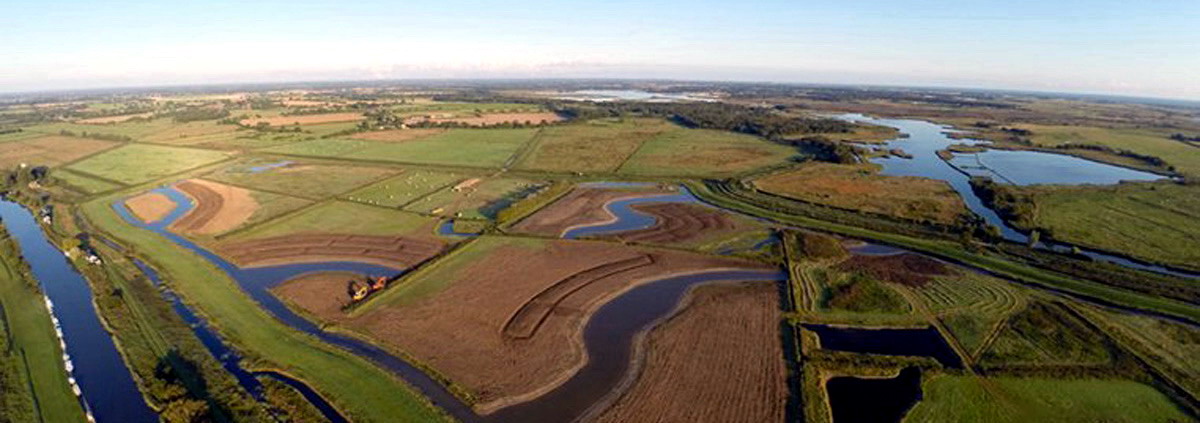
Bird Watching
Bird watching Tours in Norfolk & beyond
We have a colour & sound CCTV Bird Box on the Silver Birch tree next to the boat dyke, so that you can watch what the birds are doing on their own TV channel in Moonriver. The CCTV Bird Box has a day and night vision camera with infa-red lights that do not disturbe the nesting birds. A live TV show 24/7 during the nesting season.
Our guests have told us about a whole range of Birds and other Wildlife that the see from our holiday cottage garden, or when walking along the riverbank. So this year we are going to leave a Bird & Wildlife Log Book at Moonriver so that guests can record what they have seen which may help other guests to see the local Raptors, Marsh Harrier, Kestrel, Red Kite, Hen Harrier, Sparrow Hawk, Barn Owls, Short Eared Owl, Kingfisher, Bitten, Egyptian Geese, Cranes, Reed Bunting, Grebe, grass snake, deer, etc. Over the years we have spotted over 40 bird species so now we can all record what we see.
Fat balls and seed from Latham`s, Potter Heigham is very reasonably priced and helps to attract even more birds. Several fat ball holders have been hung in a willow tree which can be seen from the Lounge.
Potter Wetland Reserve – New – opposite Moonriver
A “wetland nature reserve” has been built on the land on the other side of the river from us, so please bring your binoculars as you will see lots of wildlife.
A new wetland has been created to optimise the habitat for rare breeding birds including Bittern and Marsh Harrier which require reedbeds for breeding and feeding.
Norfolk Wildlife Trust, has added 100 acres of wetland, including 50 acres of reedbed between the River Thurne and Candle Dyke near Potter Heigham, which is all opposite Moonriver.
This project at Potter Heigham was initiated by the Environment Agency to compensate for the anticipated loss of European-designated reed beds on the East Anglian coast due to future sea level rise and coastal erosion. To compensate, a perimeter bank and ditches with water control structures were initially constructed in 2013 and 2014 near the River Thurne by Fen Group.
As additional internal works were required to the area, William Morfoot Lt was appointed in August 2014 to further enhance the wetland habitat, which has since seen Marsh Harriers now using it for hunting, as well as sightings of Barn Owls and a Long-Eared Owl.
Tim Sisson, Managing Director of William Morfoot Ltd said: “We have successfully conducted works in wetland areas for numerous years. We were delighted when we were appointed by Norfolk Wildlife Trust and The Environment Agency to complete works at this important site in Potter Heigham.”
He added: “There are huge sensitivities around a project of this kind. Careful planning and working incredibly closely with Norfolk Wildlife Trust and The Environment Agency has enabled us to enhance the natural habitat for these rare bird species.”
As part of the five-week project, William Morfoot Ltd created seven open areas of deep water at the Potter reed bed creation site which link up to the internal perimeter ditch. The deep water pools are essential as they provide a safe area for fish, which become prey for the Bittern species.
Over 25,000m³ of soil was excavated in order to create the pools which are up to 1.5m deep.
The resulting spoil was spread over the neighbouring land in thin layers or in some cases as low ridges. The pools are now deep enough to prevent establishment by reeds so should stay open for many years.
Broadwood Conservation Management have planted more than 40,000 reeds around each of the seven pools to create the ideal feeding habitat for the Bittern species. The network of reed-filled ditches across the site will also aid in the spread of reeds to compliment the planting of the reed plugs, grown from Hickling reed seeds by British Wild Flower Plants, as the site wets up.
Nick Carter, Wetlands Project Officer at Norfolk Wildlife Trust said: “The additional works carried out will really make the site attractive to feeding Bitterns and creates large areas of open water. The creation of this new wetland will attract many additional bird species, not only the two target species of Bittern and Marsh Harrier, but also Bearded Tit, Water Rail, Reed, Sedge and Cetti’s Warblers and Little Egrets.”
The Bird ID company www.birdtour.co.uk
Tel – 01263 861 892 M: 0785 53 47 34
Email Info@BirdTour.co.uk
Blog – http://norfolkbirdtours.wordpress.com/
Phone Marcus Nash and book a tour, you will see birds, etc that you would not otherwise see.
Stuart is available to guide most days of the week, if there is nothing scheduled please contact him, rates can be negotiated for small groups on customised tours.
3rd June 2018 – Early Summer, Day 3
Posted on June 4, 2018 | Leave a comment
Day 3 of a three day long weekend of Early Summer Tours, our last day, and we would be heading down to the Brecks today. It was meant to be brighter with sunny intervals today, after the overnight mist burnt back to the coast, and it was eventually although it took a bit longer than forecast.
Our first stop was at Weeting Heath and we made our way straight out to the West Hide. As soon as we opened the flaps, we could see there were plenty of Stone Curlews on view – it was more a questions of how many! The closest birds were a pair with two well-grown juveniles. We had a good look at them through the scope. We could see their large eyes with a prominent yellow iris. The juvenile Stone Curlews were still slightly smaller than the adults and with less well-marked face patterns and wing bars.
Further over were four more adult Stone Curlews, presumably non-breeding birds, at least so far. Two of the birds appeared to be trying to pair up, bowing in display to each other. This had attracted the attention of the other two, who stood tall nearby. There was lots of running round and some calling too.

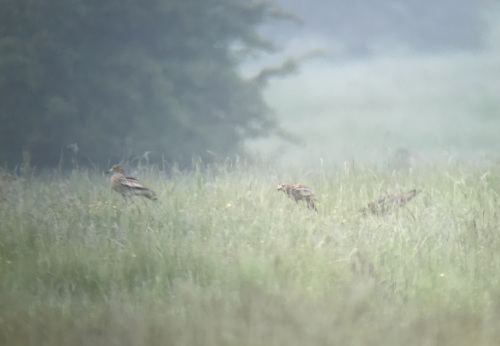
Stone Curlew – a pair bowing to each other while a third looks on
While we were watching the Stone Curlews, a Eurasian Curlew flew in calling and landed out on the grass with them. Stone Curlews are not really related to Curlews at all – just that their calls sound rather similar, which is why they got their name. They look very different too. A pair of Mistle Thrushes were lost in the long grass, but helpfully flew across in front of the hide.
As we came out of the hide, we noticed some movement high in the pines. A pair of Spotted Flycatchers were flying round in the trees, catching insects. They were high up and hard to follow at times. After a while they disappeared back into the pines and we lost track of them. There were also a couple of Coal Tits in the trees here, and we could hear a Treecreeper singing. We had a busy morning planned, so we couldn’t hang around here too long today.
We made our way on to Lakenheath Fen nest, which we wanted to explore before lunch. As we came out of the Visitor Centre, a Kingfisher flew from the reeds, out of sight just below the boardwalk. It headed off back across pool, a streak of electric blue catching the light. It landed briefly on the post at the back and appeared to have something in its bill. Unfortunately, it didn’t hang around and was straight off back over the reeds beyond.
As we walked out along the path, we could hear a Cuckoo singing. It flew out of the poplars ahead of us and out over the railway, the first of several we would see here today. There were Reed Warblers and a Sedge Warbler singing from the reeds beside the path. A Cetti’s Warbler shouted at us too. And a Common Whitethroat and several Blackcaps were singing in the trees.
From New Fen Viewpoint, we could see an adult Great Crested Grebe. A large stripy-headed juvenile swam out to join it, pestering it for food or a lift, with little success. There was not much else of note visible though, so after rest, we set off again.
As we walked along the bank, scanning the pools and the reeds, our first Bittern of the day flew up over the reeds in front of us. It flew across past us, before eventually dropping back down into the reeds behind us. A great start! We could hear another male Cuckoo singing further along and when we got there, we found it flying in and out of the sallows.

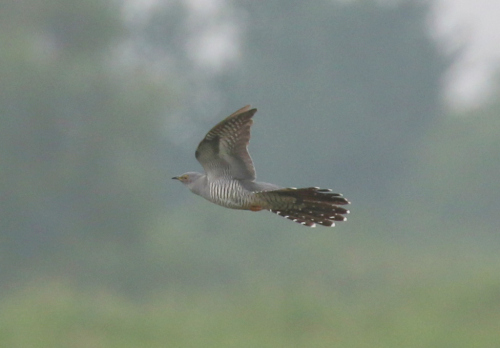
Cuckoo – flying in and out of the bushes, singing
The male Cuckoo perched up nicely a couple of times, and seemed to be focusing its attention on one large sallow bush. Then we realised it was chasing a female Cuckoo which was hiding in there. The two of them emerged and chased each other in and out a couple of times, perched up briefly, and then headed away over the reeds.
It was starting to warm up, even if it was still cloudy. There were good numbers of dragonflies out now – lots of Four-spotted Chasers in the reeds by the path, occasionally flying up before returning to their favoured perch. In amongst them we found a couple of female Scarce Chasers too, lacking the four extra spots on their wings. Several Black-tailed Skimmers were basking on the path, and kept flying off ahead of us before resettling further along. We saw a couple of Hairy Dragonflys and an Emperor here as well.


Four-spotted Chaser – there were lots of them in the reeds today
There was a nice selection of damselflies here too. A smart male Banded Demoiselle fluttered across the reeds in front of us. There were lots of Azure Damselflies in the vegetation by the path and looking carefully through a small selection of them we managed to find a Variable Damselfly with them. The vegetation also held plenty of Blue-tailed Damselflies and a few Red-eyed Damselflies too.
As we got to the junction with the path to Mere Hide, we spotted a Hobby coming fast and low over the reeds. It was after the dragonflies too. We watched it swooping back and forth, occasionally swooping up or skimming low just over the reeds, dropping down over the Mere Hide pool. We got a great look at it as it passed right in front of us a couple of times. Then it flew up and disappeared into the West Wood.

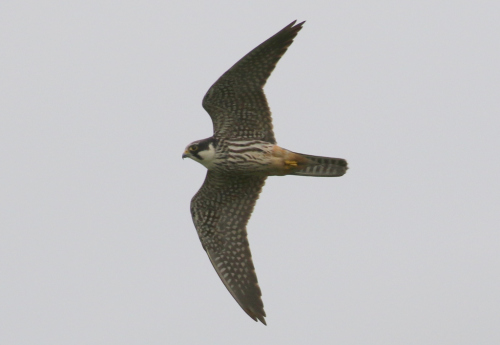
Hobby – chasing dragonflies over the reeds in front of us
Continuing on up the path, we stopped to watch another pair of Great Crested Grebes on one of the pools. They had four juveniles, quite a bit smaller than the one we had seen earlier. The youngsters were chasing around after the adults, trying to hitch a ride. One adult Great Crested Grebe kept diving to get away from them, but the other eventually stopped preening and relented.
The juvenile Great Crested Grebes climbed up onto the adult’s back. It appeared there was only room for three though – we could see their heads poking out from under its wings, but the fourth juvenile swam round beside them.

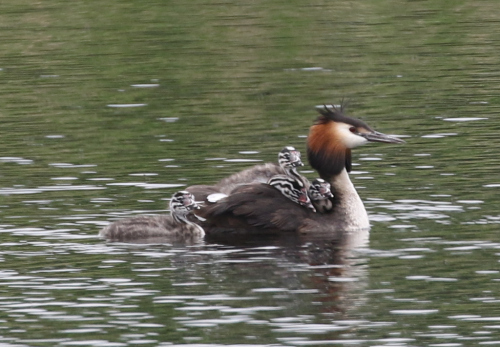
Great Crested Grebe – three of the juveniles hitched a ride, but no room for the fourth
It was all action here, we didn’t know where to look. While we were watching the grebes, another Bittern flew towards us the other side of the path. We turned in good time to see it coming and watched as it passed by us just a short distance away. We had a great view of it, like a brown speckled heron, with a fatter neck.
From the photos we could see the Bittern was a ringed bird, probably the same one we also saw here in pretty much the same spot last year.

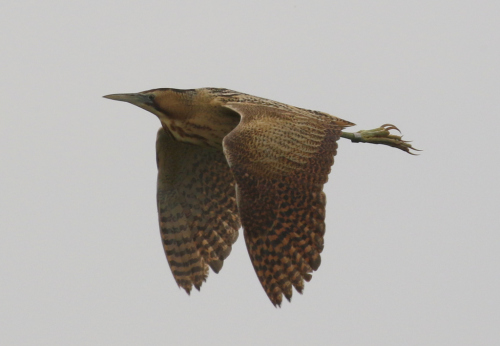
Bittern – we had a great view as it flew right past us
There was a dapper male Reed Bunting singing on the other side of path, perched up on the top of a reed stem demanding our attention too. Eventually, we had to tear ourselves away from all the birds here and we continued on up to the Joist Fen Viewpoint.
From here, we could see several Marsh Harriers circling up over the reeds, and a couple of them perched in the sallows out in the middle. A Cetti’s Warbler shouted from the bush just beside us. We were just discussing how we would only see it if it flew out, when it did just that, flying right across in front of us to the elders the other side.
After a rest, we set off to walk back. We called in at Mere Hide on the way. There had been a Bittern on the edge of the pool earlier, but it had gone back into the reeds now. However, while we were there another Bittern flew across over the reeds in front of us and yet another one was booming in the reeds out to the left of the hide. Bitterns everywhere! There have been 10 booming males here this year, a record for the reserve. Not bad considering there were just 11 in the whole of the UK in 1997, at their lowest point.
It was just a quick stop in Mere Hide, as we had to get back for an already late lunch. The sun was out now, and it was getting quite hot as we walked back. It was nice and cool in the Visitor Centre, so we ate in there today. Most of the group could not resist the cold drinks from the fridge and the ice cream went down very well too!
After lunch, we made a quick visit to Lynford Arboretum. We were hoping for a few woodland birds to add to the list, but it was rather quiet here in the heat of the afternoon. We stopped by the gates to look into the walled garden and hear a Nuthatch calling. We looked up to see it in the pines at the back. It was carrying some food in its bill, and then dropped down to a nestbox on the wall, where a nestling’s head popped out to be fed.
Shortly after we had watched the young Nuthatch being fed, a Kestrel swooped low across the grass in front of us pursued by a couple of Swallows. It crashed onto the front of the nestbox and then sat on the top. It looked like it might have been after the Nuthatch nestlings, although without the adult there they were presumably not at the hole on the front. After sitting on the top of the box for a couple of minutes, the Kestrel flew off again, chased by the Swallows once more.


Kestrel – was it after the Nuthatch nestlings in the box below?
While we were watching all the action in the garden, we heard a Grey Wagtail flying over behind us. When we got back onto the path, it was standing in the middle just round the corner, back towards the road. It stood there for a few seconds preening, before flying off.
As we made our way down to the lake, we could hear several Siskins flying round high above the trees. A Goldcrest was calling in the firs down at the bottom of the hill and we had a nice view of it when it came out onto the branches on the edge. Another Nuthatch flew across the path and up into the trees where we could hear it piping.
Round on the lakeside path, the pair of Mute Swans had brought their two cygnets out of the water and the male would not let us pass. Eventually, he gave in to the pressure of us trying to walk on and led them back into the lake. A Little Grebe laughed from out on the water, and we saw one surface out on the lake among the lily pads. The walk back through the Arboretum was uneventful, apart from a Common Lizard which was basking on the path and scuttled off ahead of us.
There was one last target for the day – Tree Pipit. So we drove back into the forest and parked by the start of a ride. The walk in and round the first clearing was quiet, apart from a Garden Warbler singing from bushes. There were more butterflies out now in the sunshine – as well as several whites, we saw a couple of Orange Tips, one or two Painted Ladys, a few Common Blues and a Large Skipper.

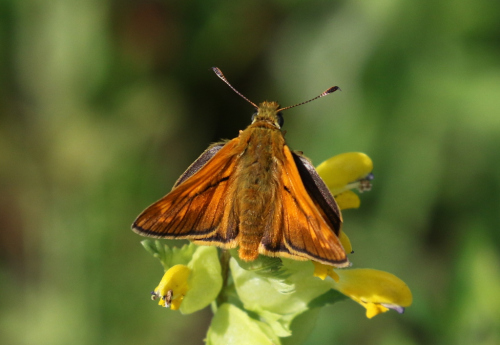
Large Skipper – there were lots more butterflies out this afternoon
We walked on through the trees to a second clearing, and could immediately hear a Tree Pipit singing towards the back. As we made our way round to the other side we could see it song flighting, towering up singing and then parachuting back down to into the top of one of the trees. After one flight, the Tree Pipit landed on some wires, and we got it in the scope. We had a great view of it, even noting the strongly curved hind claw.

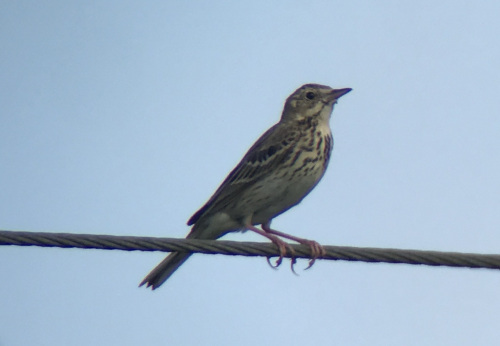
Tree Pipit – singing and song-flighting from the wires over a clearingn
Another Tree Pipit started singing away in the distance. Then one of the group noticed a small bird flying across the clearing behind us, which landed on the top of a tall tree stump out in the middle. We got it in the scope and could see it was a Woodlark. When they aren’t singing they can be very hard to find here, so this was a very nice bonus. It perched for a while before dropping down into the tall grass below.
It was now time to start walking back. On the way, a small flash of colour sped past us, not right for any butterfly. It landed down in the grass briefly and we could see it was a Cream-spot Tiger moth, its black upperwings marked with bold creamy splodges. Then it was off again – revealing its bright red abdomen and yellow underwings. They are not a common moth and in Norfolk are found mainly in the Brecks.
It had been a very successful last stop, a great way to finish off the three days. We had seen some really good birds and some other interesting wildlife too.
It had been a very successful last stop, a great way to finish off the three days. We had seen some really good birds and some other interesting wildlife too.
It had been a very successful last stop, a great way to finish off the three days. We had seen some really good birds and some other interesting wildlife too.
It had been a very successful last stop, a great way to finish off the three days. We had seen some really good birds and some other interesting wildlife too.
